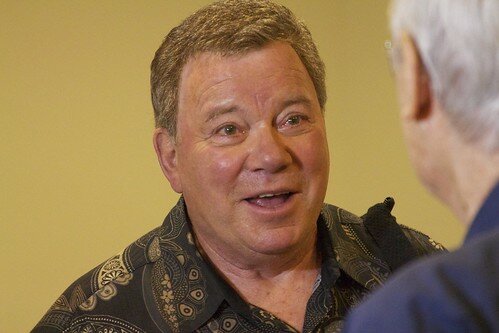For some, the word “goof” is associated with a dim-witted but lovable Disney character. For Canadians, “goof” is the ultimate insult, on par with being called a child molester. Walk into a bar in Canada and call someone a goof and you will get your ass kicked.
A “goof” may be completely harmless and well-meaning. The goof wants to be liked. But something is… off about him. His behaviour isn’t quite normal. It’s persistently annoying. He’s the opposite of the level-headed Canadian exemplar.
People notice and target the goof. Women won’t touch the goof. If you see him, cross the street. His actions can’t go unpunished. And he’s got to reassert his place in the social order by fighting.
Sometimes, however, the goof gets the last laugh. They want to call me a goof? I’ll show them just how goofy I can be!
And that, ladies and gentlemen, is how you get William Shatner.
Some of you may know that Shatner had a long and difficult climb to the top. He actually started as Christopher Plummer’s understudy, and he only became a hero to legions of Trekkies after the original show went into syndication. He spent part of the early ’70s effectively homeless, taking any acting job that came his way. His career is literally one of faking it until he made it. So while Shatner is an unrepentant goof, he comes by it honestly, and managed to scratch and claw out a space for himself that nobody else could occupy – or would want to occupy.
There are obvious comparisons to Mordechai Richler – both men were the children of immigrant Jewish families from Montreal and who embraced their roles as outsiders. Did they rub their contemporaries the wrong way? Of course they did. But these men had good reason to feel as though they were being unfairly pushed into the background. To succeed, they had to be Samsons, pushing down the walls around them even if they harmed themselves and those close to them. You can also compare him to visionaries like Cronenberg and Maddin, who embraced the weird but never truly abandoned the mundane.
He is both hero and clown. You cheer for Shatner because he is desperately trying to fit himself into the box of normalcy – the competent starship captain, the gritty lawman T. J. Hooker, the Priceline.com pitchman, or… whatever Denny Crane on Boston Legal was supposed to be – and failing miserably. He wants to be Plummer, or Sutherland, or, failing that, Leslie Nielsen, but he can’t be. By the time he was cast as Denny Crane, the Shatner persona had obliterated any mere role he was supposed to be playing. He was just Shatner, so far beyond the point of shame that he was the star attraction of his own Comedy Central roast.
Next week, we’ll break from our one actor/actress per week formula and invoke one of the all time great sci-fi debates – Star Trek vs. Star Wars – and explore why Canadians gravitate towards one, but were never fully comfortable with the other.
****
See the previous installments in the series:
Part 1 on Heroes: ‘Scott Pilgrim Vs The World’ Vs Terrance Denby and ‘Sidequest’
Part 2 on “Humour”: The Libertarian Fantasy of ‘Letterkenny’
Part 3 on Graphic Novel Nihilism: The Harsh Truths of ‘Essex County’
Part 4 on Spawn and Wolverine: Banished From The Promised Land: A Tale of Two Canadian Anti-Heroes
Part 5 on Science Fiction Dystopias: Inside Quebec’s – and Canada’s – Replicant Culture
Part 6 on Animation: The Garrison Mentality: More Than Meets The Eye
Part 7 on Pop Music: How To Build A Successful Canadian Musical Act
Part 8 on Anne of Green Gables and The Traumatized Artist: Lucy Maud Montgomery’s Treacherous Alpine Path
Part 9 on Avoiding the Serious: Mordecai Richler, Montreal, And Gritty Realism
Part 10 on Southern Ontario Gothic: The Marriage of the Mundane and the Fantastic
Part 11 on Margaret Atwood’s Reign of Terror: Literary Tyranny and The Handmaid’s Tale
Part 12 on the First Nations Fraud: Whitewashing Genocide: Truth, Lies, and Joseph Boyden
Part 13 on the inventive Esi Edugyan: A Novel I Cannot Recommend Enough
Part 14 on Generation X Origins: Douglas Coupland And The Hopeful (?) Future Of Canadian (?) Culture
Part 15 on Jordan Peterson Rising: Canadian Culture Creators And The Intellectual Dark Web
Part 16 on The Awkward Quiet: David Cronenberg’s Silent Hell
Part 17 on The Saddest Music In The World: Guy Maddin’s Surrealist Madness
Part 18 on Ararat: Atom Egoyan’s Stammering Grief
Part 19 on Paul Haggis’ Superficial Gloss: Promising More Than He Delivers
Part 20 on the Reitman Family’s Blissful Ignorance: Space to Laugh an Easy Laugh
Part 21 on Mary Pickford: The Archetypal (Canadian) Actress
Part 22 on the Modern Prospero Christopher Plummer: As Blue-Blooded and Upper Canadian as They Come
Part 23 on Donald Sutherland: Grit Personified
Part 24 on Leslie Nielsen: The Funniest Thing in a Movie Where Jokes are Delivered Almost Every Minute
****
Photo by Gudlyf 



Comments
Josh, I only know William Shatner from the Star Trek series. I intentionally avoided his decades in other roles except for an odd and scary horror film he did in the sixties. I agree that he’s goofy, yet his character as James T. Kirk always carried an American nobility–Big Sky country–a Western in outer space, and the captain gifted with John Wayne’s swagger. Looking forward to the great sci-fi debate in your next post.